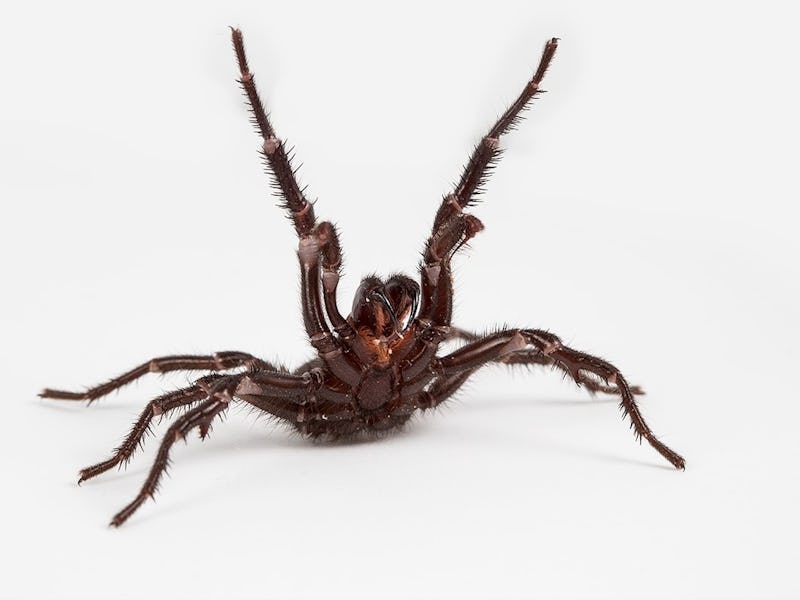Notorious Australian spiders kill humans by "evolutionary coincidence"
A new study explains how a highly venomous group of spiders got their powers.

The Sydney funnel-web spider's venom is exceedingly dangerous. Its neurotoxic effects attack the human body, and can kill a person in just 15 minutes. It is capable of piercing its large fangs through skin, fingernails, and even shoe leather.
The arachnid is just one of about 40 known species of Australian funnel-web spiders. New research examines how this terrifying group of spiders came to have their venomous superpowers.
Australian funnel-web spiders first developed their venom as a defense mechanism against insect predators, like flies and cockroaches. But as time went on, their toxic effects were repurposed to target vertebrates, causing the fatal-to-humans effect that earned the spiders infamy.
This macabre origin story is described in a new study, published Monday in the journal Proceedings of the National Academy of Sciences. In it, the researchers call the lethal effects of the Australian spiders an "unfortunate evolutionary coincidence."
Bryan Fry, associate professor at the University of Queensland, led the study. He explains why, in terms of evolution, it was surprising that funnel-web spiders are so deadly to Homo sapiens — and that the spiders have clear sex differences when it comes to venom potency.
"It has puzzled scientists why these toxins are so deadly to humans, when they and other primates, haven't featured as either prey or predator during the spider's evolution," Fry said in a statement. "And we couldn't understand why most human deaths were being caused by male funnel web spiders, which seemingly had much deadlier venom than females."
Venomous fangs of an Australian funnel web spider.
Funnel-web spiders' venom contains chemicals called Delta-hexatoxins, which are toxic to humans' nervous systems. They cause nerves to turn on and fire uncontrollably. This effect leads to symptoms like sweating, vomiting, and muscle spasms — and can even result in death.
Researchers sequenced RNA from the venom glands of 10 funnel-web spider species, uncovering 22 Delta-hexatoxins. Analyzing the spiders' evolution reveals these toxins, which have ancient origins, remain a key part of the spiders' makeup thanks to "extreme conservation" of the trait.
In experiments, researchers got into why that might be the case — and why these spiders are toxic to humans, whom are not the spiders' natural predators. Scientists isolated the lethal Delta-hexatoxin and tested it in mice, finding that the toxin causes pain — the defense mechanism in action.
Humans are not the intended target of Delta-hexatoxins, but the toxins "likely evolved to deter vertebrate predators commonly encountered by these spiders, such as bandicoots, birds, and lizards," the study authors write.
"Thus, the lethal potency of [Delta-hexatoxins] against humans is an unfortunate evolutionary coincidence."
As for the male-female differences, researchers also discovered new clues as to why males' venom is more potent than their female counterparts'.
When male funnel-web spiders reach sexual maturity, they leave their burrows in search of a female — sometimes wandering for long distances, Fry explains. Along the way, the spiders may run into dangerous predators.
"The data shows that natural selection put the necessary pressure on to switch an insect-specific venom into a vertebrate-specific defensive venom," Fry said. "And, unluckily for us, we're a vertebrate species which copped it in the process."
The new findings could lead to better insights about what, exactly, funnel-web spider venom does to humans' bodies. In medical science, that could help to develop treatments. It could also potentially be used to discover new insecticides.
"They're dangerous as hell," Fry said, "but male funnel web spiders offer us some real opportunities."
Abstract: Australian funnel-web spiders are infamous for causing human fatalities, which are induced by venom peptides known as δ-hexatoxins (δ-HXTXs). Humans and other primates did not feature in the prey or predator spectrum during evolution of these spiders, and consequently the primate lethality of δ-HXTXs remains enigmatic. Funnel-web envenomations are mostly inflicted by male spiders that wander from their burrow in search of females during the mating season, which suggests a role for δ-HXTXs in self-defense since male spiders rarely feed during this period. Although 35 species of Australian funnel-web spiders have been described, only nine δ-HXTXs from four species have been characterized, resulting in a lack of understanding of the ecological roles and molecular evolution of δ-HXTXs. Here, by profiling venom-gland transcriptomes of 10 funnel-web species, we report 22 δ-HXTXs. Phylogenetic and evolutionary assessments reveal a remarkable sequence conservation of δ-HXTXs despite their deep evolutionary origin within funnel-web spiders, consistent with a defensive role. We demonstrate that δ-HXTX-Ar1a, the lethal toxin from the Sydney funnel-web spider Atrax robustus, induces pain in mice by inhibiting inactivation of voltage-gated sodium (NaV) channels involved in nociceptive signaling. δ-HXTX-Ar1a also inhibited inactivation of cockroach NaV channels and was insecticidal to sheep blowflies. Considering their algogenic effects in mice, potent insecticidal effects, and high levels of sequence conservation, we propose that the δ-HXTXs were repurposed from an initial insecticidal predatory function to a role in defending against nonhuman vertebrate predators by male spiders, with their lethal effects on humans being an unfortunate evolutionary coincidence.